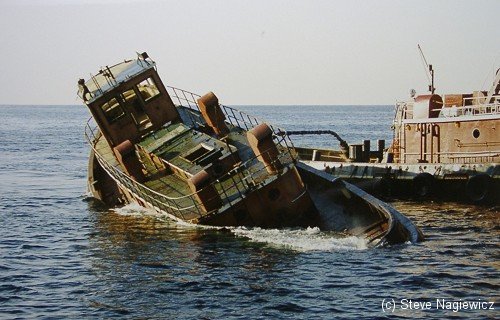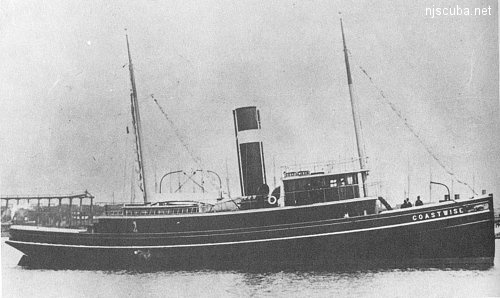Army Tanks

The Artificial Reef Program used four types of obsolete Army armored vehicles as artificial reef materials off the New Jersey coast. These were cleaned at local military bases, loaded onto barges for transport, and pushed off at their final destination. Once the Army had disposed of its excess inventory, the program ceased, around 1999. The Artificial Reef Program has sunk almost 400 tanks altogether, far too many to list them here in this website.
By far the most numerous sunken tanks are APCs, or Armored Personnel Carriers, aluminum-bodied Vietnam-era M113 models ( and really not tanks at all ). Other Army vehicles used as artificial reef materials include light and heavy tanks and armored cranes. Tanks were also used off Long Island.
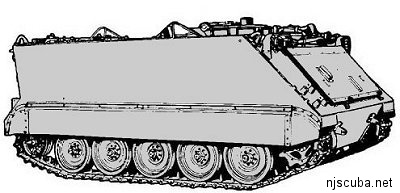
hull length: 15 ft, weight: 13 tons
The M113 is an armored personnel carrier family. It was first introduced in 1960, developed from the M59 and M75 which were designed by Ford and Kaiser Aluminum and Chemical Co. in the late 1950s. It is a tracked vehicle capable of amphibious operation in lakes and streams, extended cross-country travel over rough terrain, and high-speed operation on improved roads. The M113 family has many variants that are used in a variety of combat and combat support roles, with approximately 80,000 units having been produced.
The M113 was the first modern "battle taxi, " developed to transport infantry forces on the mechanized battlefield; it requires a crew of two and can carry an additional seven infantry. Its main armament is a single .50 Cal heavy barrel machine gun, with secondary armament consisting of a single .30 Cal machine gun. The M113 is built of aircraft-quality aluminum which allows it to possess some of the same strengths as steel at a much lighter weight (the vehicle weighs approximately 13 tons). Its low weight allows the use of a relatively small engine to power the vehicle, a 2-stroke six-cylinder Detroit diesel, as well as allowing the vehicle to carry a large payload cross-country and to be transported by aircraft.
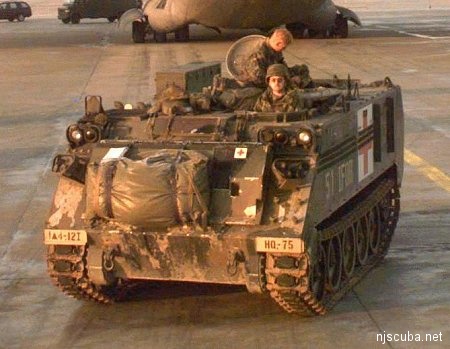
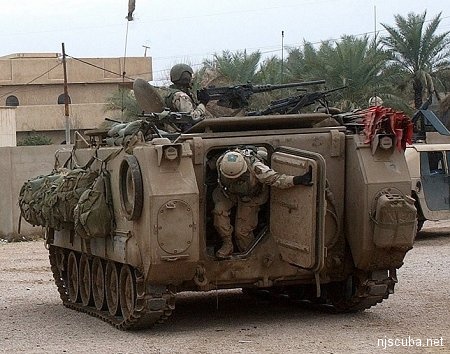
The M113 has a 300-mile range and a maximum speed of 40 mph. The upgraded M113A3 has added spall suppression liners, armored external fuel tanks, a more powerful engine and transmission, and mounting plates for the optional bolt-on aluminum armor.
The M113 has very light armor, insufficient against modern ammunition and weapons. The M113 basic armor can easily be penetrated by anti-tank missiles like the Russian RPG-7, and even by heavy machine-gun fire. During the Vietnam War, this APC was considered such inadequate protection that most American soldiers rode on top of the vehicle since they considered it suicidal to ride inside. Most of the M113s which are still in service are upgraded with add-on armor, reactive armor coats, and sandbag protection. However, they are still lightly protected compared to modern APCs or IFVs such as the M2 Bradley.
source: Wikipedia
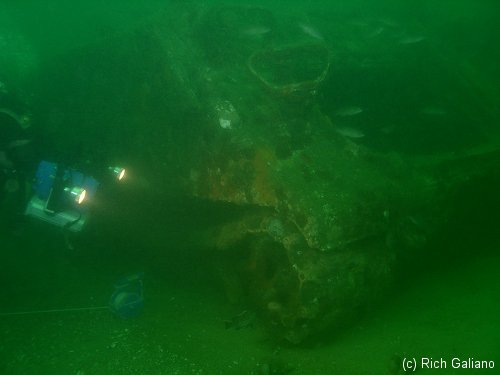
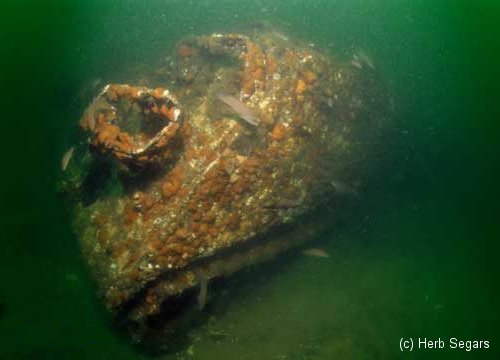
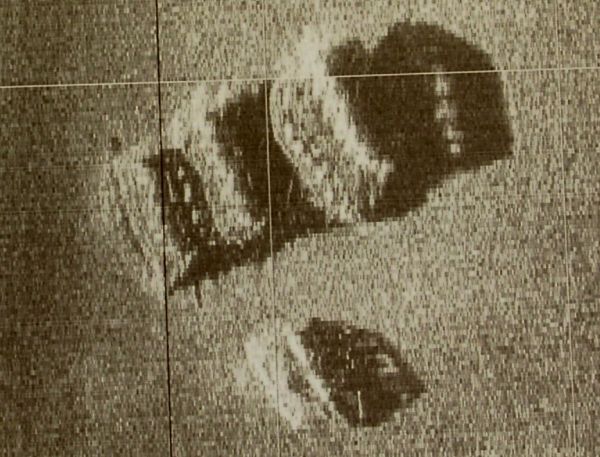
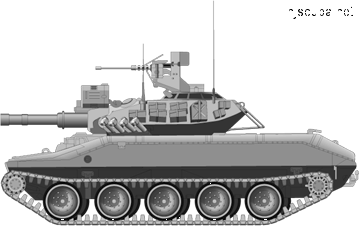
hull length: 20 ft, weight 18 tons
The M551 Sheridan tank was designed in the early 1960s, as a need arose for U.S. forces needing a light tank. Constructed of aluminum armor, it is extremely fast, using a 300 hp Detroit Diesel engine and cross drive transmission. It mounts a steel turret and an aluminum hull. It was air transportable and fully amphibious with the screen around the sides raised. The main gun fired a 152mm standard projectile or a missile. It packed a lot of punch for a small tank. A similar gun was also used on the M728 Combat Engineer Vehicle. It is equipped with nuclear, biological, and chemical protection for the crew of four men. This enables it to fight in almost any climate or situation. The vehicle has seen combat use in Vietnam, Panama, and Desert Storm, and it is used today for training in the California desert by the Armored Force Opposing Forces training center. Weight is 34,900 lbs. Top speed is 43 mph. It was built by the Allison Division of General Motors.

The M551 Sheridan was developed to provide the US Army with a light armored reconnaissance vehicle with heavy firepower. The main armament consists of a 152mm M81 gun/missile launcher capable of firing conventional ammunition and the MGM-51 Shillelagh antitank missile ( 20 conventional rounds and 8 missiles ). Due to problems with the gun-tube-launched antitank missile, the Sheridan was not fielded widely throughout the Army. The gun would foul with case-less ammunition, gun firing would interfere with missile electronics, and the entire vehicle recoiled with unusual vigor when the gun was fired since the 152mm gun was too big for the light-weight chassis. The Shillelagh missiles were evidently never used in anger. In addition to the main gun/missile launcher, the M551 is armed with a 7.62mm M240 machine gun and a 12.7mm M2 HB antiaircraft machine gun. A Detroit Diesel 6V-53T 300hp turbocharged V-6 diesel engine and an Allison TG-250-2A power-shift transmission provide the Sheridan's power. Protection for the four-man crew is provided by an aluminum hull and steel turret. Although light enough to be airdrop-capable, the aluminum armor was thin enough to be pierced by heavy machine-gun rounds, and the vehicle was particularly vulnerable to mines.
Initially produced in 1966, the M551 was fielded in 1968. 1,562 M551s were built between 1966 and 1970. The Sheridan saw limited action in Vietnam, where many deficiencies were revealed. The missile system was useless against an enemy that employed no tanks, though the Sheridan saw a lot of use towards the end of the war because of its mobility. Sheridan-equipped units participated in Operation Just Cause in Panama (1989) and were deployed to Saudi Arabia during Operation Desert Shield. As projectile technology advanced, the Sheridan's potential declined and it was phased out of the US inventory beginning in 1978. The M551 was last used by the 82nd Airborne Division. Some 330 "visually-modified" Sheridans represent threat tanks and armored vehicles at the National Training Center in Fort Irwin, California.
source: globalsecurity.org
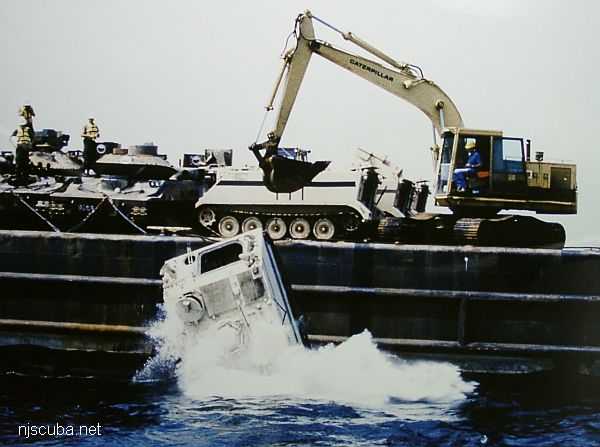
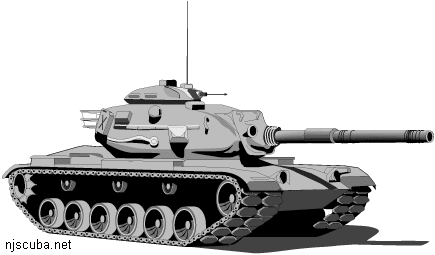
hull length: 23 ft, weight: 58 tons
The M60 series tank succeeded the M47 and M48 Series. The improved design provided an increased operational range and mobility, required a minimum of refueling and servicing, and incorporated an improved main armament. A Continental V-12 750 hp. air-cooled diesel engine powers the vehicle. Power is transmitted to a final drive through a cross drive transmission, which is a combined transmission, differential, steering, and braking unit. The hull of this vehicle is a one-piece steel casting and is divided into two compartments, the crew in the front, and the engine at the rear.
The M60 Patton main battle tank is now primarily found in US Reserve and National Guard units, but served as the primary US main battle tank for two decades prior to the introduction of the M1. Developed from the M48 Patton series, the M60 was fitted with a 105mm main gun and manned by a four-man crew. Criticized for its high profile and limited cross-country mobility, this durable tank proved reliable and underwent many updates over its service life. Rarely has one vehicle type labored as the principal main battle tank for as long as the stalwart M60. The interior layout, based on the excellent design of the M26/46/47/M48, provided ample room for updates and improvements, extending the vehicle's service life for over four decades.

In the early 1950s, reports from British intelligence indicated the Soviets had developed a new heavily armored medium tank, the T-54. This new tank was armed with a 100mm gun, superior to the American M48 medium tank, which used an old 90mm main weapon developed in WWII. In response, the US developed a strategy to bring the M48 up a level to compete with the new Soviet tank -- the M60. Initially produced in 1960, over 15,000 M60s were built by Chrysler and first saw service in 1961. Production ended in 1983, but 5,400 older models were converted to the M60A3 variant ending in 1990. This tank saw action with the Israeli forces during the Yom Kippur War in both the Sinai and the Golan Heights.
Besides its main gun, the M60 series tanks are equipped with a 7.62mm M240 coaxial machine gun and a 12.7mm M85 antiaircraft gun. Power is provided by a Continental AVDS-1790-2C 750 hp V-12 engine and an Allison CD-850-6/6A power-shift cross-drive transmission. The first M-60s retained a turret similar to the M-48 but had a revised hull with better ballistic protection. The M60 tank hull was designed with a unique rounded boat shape, made from five cast pieces that combine to provide excellent ballistic protection for the four crew and equipment packed inside.
The army ordered the M60 into production in 1959 and the first M60s entered service with U.S. Army units during the fall of 1960. Most of the initial production vehicles were sent to Europe to offset the Russian T-54, then coming into widespread service with Warsaw pact armies. While it was an improvement over the M48, especially in armament ( having a 105 mm gun, a much roomier M19 Commander Cupola, and new road wheels ), the M60 was regarded as somewhat of a stop-gap measure. It has 750 hp. with a maximum speed of 30 mph and a maximum range of 350 miles.
Used in Vietnam and Desert Storm, it proved itself to be a dependable vehicle in all areas of operation.
source: globalsecurity.org
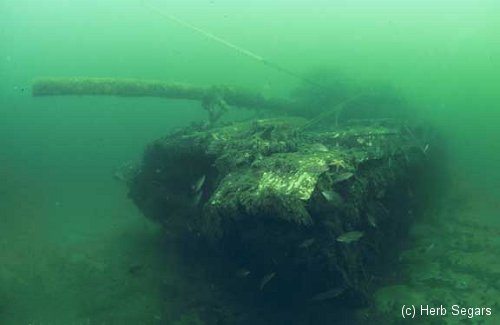
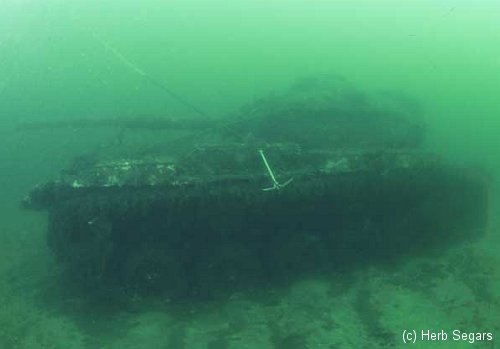
M60 Main Battle Tank ( a real tank ! ) The turret is turned around backward, to "traveling" position.

M578 Armored Recovery Vehicle ( crane ):
hull length: 19 ft, weight: 23 tons
The M578 is a fully armored heavy recovery vehicle with an armored independently operated cab and crane mounted at the rear of the hull near the rear of the vehicle. The hull, power plant, and running gear are similar to those of the M110A2 self-propelled Howitzer. It is used to recover mechanized equipment which has been bogged down, turned over, or become so disabled it can't be towed readily. It is also used by maintenance units for general repair and maintenance at repair yards or depots. The crane has a 30,000 lb., capacity, and it is outfitted with tools and equipment to be used on a daily basis. It has a crew of three men and weighs 54,000 lbs. Power is provided by a Detroit Diesel V-8 engine with 405 hp.
The M107 self-propelled 175 mm gun and the M110 self-propelled 8in (203 mm) howitzer were both characterized by rapid barrel wear and the need to be able to change the barrels frequently and simply. The US Army developed a crane for this purpose based on the tracked vehicle as the guns themselves. It has a turret with a boom rather than a gun barrel, and a winch which gave it a recovery as well as a lifting potential. This equipment, the M578, was issued to those artillery units using the guns during the 1970s. When the guns were withdrawn from service the M578 was re-designated a Light Armored Recovery Vehicle [VTR], used to recover damaged vehicles from the battlefield. The hydraulic crane is housed in a turret mounted at the rear of the chassis. A stabilizing spade hydraulically lowers from the rear. Used in both Vietnam war and Desert Storm.
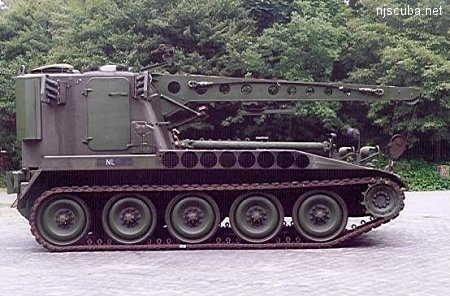
source: globalsecurity.org
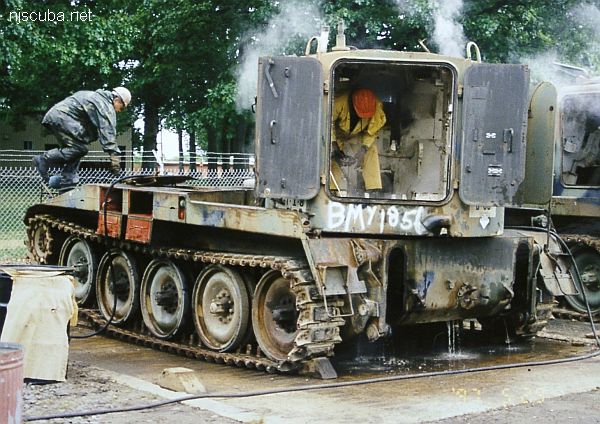
M578 armored cranes being cleaned prior to sinking.

Building New Reefs
Story by MSgt. Bob Haskell
Photos by SFC Declan Callan
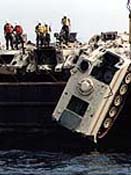
Don Cramer is an amiable old salt who has seen just about everything -- worn tires, stone slabs from the remodeled Benjamin Franklin Bridge, tug boats, and part of an oil refinery -- deep-sixed off New Jersey to make salt-water havens for fish. Now the charter-boat skipper out of Stone Harbor, N.J., can add demilitarized Army tanks and armored personnel carriers to the material used to build and sustain artificial reefs a few miles out in the rolling Atlantic.
Reef Exercise, REEFEX for short, is a program spearheaded by the New Jersey Army National Guard intended to reinforce the sport-fishing industry off the mid-Atlantic shore -- from Long Island to North Carolina -- and help people like Don Cramer earn a living. He is a third-generation charter-boat captain who has been hauling fishing parties beyond the New Jersey horizon for 40 years in search of sea bass, blackfish, porgy, and other species that thrive on the worms, snails, and other organisms that grow on reefs.
Holsey Moorman is a brigadier general in the New Jersey Army National Guard who is convinced the armed forces have plenty of old equipment that is ideal for building these reefs and that the Guard and other government agencies have the muscle to drop it to the ocean floor where it can do the most good.

"You either cut it up for scrap or use it for something like this, " said Moorman, New Jersey's deputy adjutant general, who learned about the program during a tour at the Pentagon. "Considering scrap metal is going for about $13 a ton, there is a lot more financial benefit from using it to help the sport-fishing industry."
Consequently, 181 M60 tanks, Sheridan armored reconnaissance vehicles, and M113 APCs that new technology and the Army's downsizing have made obsolete were gutted for spare parts, drained of their polluting fluids, and steamed squeaky clean at Fort Dix before being shoved from barges into 50 feet of ocean off the New York, New Jersey, Delaware, Maryland and Virginia coasts in August and September.
Members of the New Jersey Army Guard, primarily from the 119th Support Battalion, have worked on the reef project since 1994, said Lt. Col. Charles Harvey, the battalion's commander. "It's a good morale booster, " said Harvey as tanks were being pushed from an ocean-going barge onto New Jersey's Wildwood Reef nearly five miles off Stone Harbor. "These guys work their tails off."

The New Jersey Guard heads the program, said Moorman, because Fort Dix has the only federally-certified facility for stripping and cleaning the tracked vehicles in the region. About 30 Guard members worked on this year's $1.3-million effort, which was funded by the Defense Department. Armored vehicles from Forts Stewart and Benning in Georgia and from Anniston Army Depot in Alabama were sanitized at Fort Dix and transported to barges at the Earle Naval Weapons Station on the New Jersey shore before being dumped off the mid-Atlantic coast.
The tanks and APCs are expected to form patch reefs where the water is green and rich in algae and plankton but where natural reefs do not exist. "Tanks have a relatively high profile. Triggerfish, baitfish, and round herring will school up over high structures, " explained Bill Figley, reef coordinator for the New Jersey Division of Fish, Game, and Wildlife. The old military vehicles are the newest building blocks for artificial reefs that have been built off the Atlantic coast since the 1930s, Figley said. New Jersey alone has established 14 reef sites since 1983, using enough material to build a single-lane highway four feet deep and 172 miles long.
Hundreds of sanitized military vehicles have been placed on reef sites off the Atlantic Coast and the Gulf of Mexico during the last three years with the help of Army Guard units from Louisiana and Georgia as well as from New Jersey, officials explained. It takes four or five years for a reef to develop the thick layer of vegetation and the small animals to feed a lot of fish, Figley said. Fish, however, start to colonize, and hide from predators, within days after the old boats and tanks hit bottom.
The heavy armored vehicles' anticipated durability of 50 to 100 years is critical, said Figley. "We try to put down materials that aren't going to break apart, " he explained. Once in place, the reefs can produce a lot of food. Those off New Jersey are sustaining up to 300 million pounds of mussels, he said. In some places, there are 5,000 mussels per square foot.
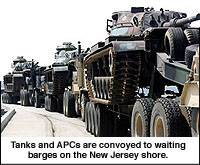
Noble as this military machinery's final mission may be, armor soldiers get downright melancholy when the tanks that were designed to move and fire on land take a plunge beneath the waves. "I got down inside a turret to look around one last time back on land, " lamented New Jersey Army Guard Maj. Ernest Huggard as six M60s from his former tank company were sent to their final resting places. "I guess they call it obsolete today, " added Huggard, "but by our standards, five years ago it was the newest thing we had."
Reprinted from the US Army website

